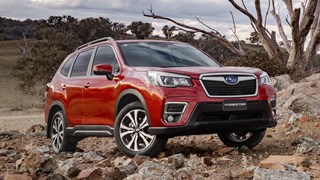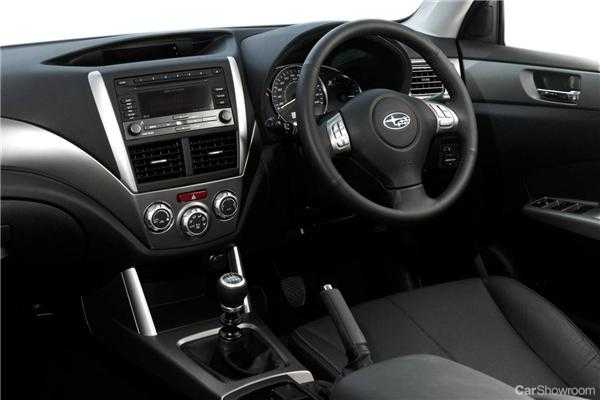Since the local launch of the original Forester in 1997, Subaru Australia has sold 137,000 cars to consistently dominate what is now a crowded compact sports utility vehicle market. Buyers have long been invited to consider the Subaru Forester as the ideal urban car for a dirty weekend and it has always had more offroad credibility than many rivals. Now, with the arrival of two diesel variants, Subaru has filled yet another niche, while at the same time underlining its unique selling proposition of ‘boxer’ engines powering all-wheel drive vehicles. The Outback and Forester are the world’s only production cars to offer a horizontally opposed diesel engine. Typically Forester sales run at about 1000 per month and general manager Nick Senior expects the diesel to bring incremental volume of 100 units per month. The Forester 2.0D is priced at $35,990 and the 2.0D Premium costs $39,990.
What You Get
All Subarus have a five-star ANCAP safety rating. The Forester comes with six airbags, electronic stability control and an impressively unobtrusive traction control system. Front fog lights, self-levelling rear suspension, hill start assist, climate control and tinted windows are standard.
The Premium variant adds leather, sunroof, 17-inch alloys (in lieu of 16s), xenon low-beam headlights, power driver’s seat and enhanced audio. The 2.0D gets a full-size steel spare while the Premium scores a fifth 17-inch alloy wheel. Attention to detail is evident in features such as the reclining rear seat with its own retractable tray and four luggage tethering hooks.
The Engine
Subaru’s unique diesel engine is only available in combination with a six-speed manual transmission. It produces 108 kW of power at 3600 rpm and offers 350 Nm of torque consistently from 1800 to 2400 rpm. Torque rather than power is the key to the Forester’s strong performance. In the lower ratios, it pulls happily from 1500 rpm. On the open road, this generous torque translates into effortless overtaking in either fifth or sixth gears.
Fuel economy is fantastic. The official combined figure is 6.4 litres per 100 kilometres but on the open road you will do much better than that. Carbon emissions are 168 g/km. Towing capacity is 1600 kg which matches the turbocharged petrol Forester and outdoes the naturally aspirated models by 200 kg. Performance is similar to the Outback diesel because, at 1520 kg, the Forester is just 30 kg lighter than its larger, lower sibling.
The Interior
Even the standard 2.0D model is well equipped and impresses with its materials. The cloth upholstery is attractive and will doubtless stand up to the rigours of family life and lots of dirty weekends. The luminescent gauges with their blue lighting could come from a much more expensive vehicle, although the omission of a temperature gauge in favour of a blue light that goes out when the engine reaches normal operating temperature is a minor disappointment.
The Premium lives up to its name with rich leather which gives a luxurious ambience to this always practical wagon. Because you sit quite high in the Forester, you feel as if you are travelling in a larger car.
Exterior & Styling
Subaru styling has been controversial in recent years but the Forester is a smart, well tailored vehicle with pleasing details such as the rich chromework of the grille and the smart wheelarches. The 17-inch alloys on the Premium are bolder than the 16s and finish the car off nicely. A wide range of attractive colours is available and, as a sign of the times, all of them are metallics.
On The Road
The Forester drives very well. Although the steering could use a little more feel and perhaps a touch more quickness of response, the overall dynamics are impressive. The ride is smooth for this type of vehicle as is the handling which, frankly, belies the reasonably high centre of gravity. While never feeling like a sports car, the Forester can be hurried through tight corners in impressive style with only moderate understeer and less body roll than Car Showroom expected.
The diesel engine is a sterling performer and that abundant torque shows to great effect on the highway. Turning off onto rough forestry trails, the Subaru lives up to its Forester name. The suspension feels especially robust and the generous ground clearance is greatly appreciated under these conditions. It must not be thought of as a go-anywhere vehicle (there is no low range for a start), but it will go further than many.
Challanges
Some buyers might prefer an automatic transmission but the standard hill start assist feature should serve as a consolation prize. The manual gearchange is a bit notchy. A touch more feel and speed to the steering would round out the dynamics.
Verdict
Subaru, long the innovator when it comes to building all-wheel drive passenger cars, has a winner in the unique Forester diesel. For buyers who want to own a genuinely different vehicle, here is one. The availability of the world’s only boxer diesel engine in such a well-priced and safe machine adds significantly to the Forester’s already considerable appeal.
The Competition
The Forester diesel will compete with the Nissan X-Trail, which has a more powerful diesel engine (127 kW versus 108) and the availability of automatic transmission but also costs more ($42,990 for the TL manual). The newly launched Hyundai iX35 Elite is priced at $34,990 with a 135 kW diesel engine. Holden’s Captiva CX has a 110 kW diesel and seven-seater capacity and costs $41,490. The $43,640 Mazda CX-7 Diesel Sports (127 kW) might also be considered a rival to the Forester 2.0D Premium.
Likes:
Unique engine design, five-star safety, outstanding value
Dislikes:
Lack of automatic variant, no temperature gauge





















